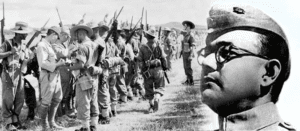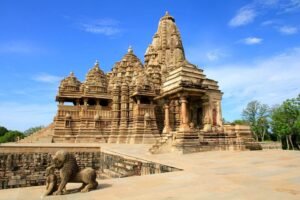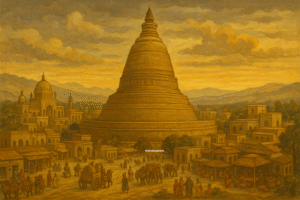Mughal Emperor Akbar the Great, also known as Jalal-ud-din Muhammad Akbar, was one of the most complex and influential rulers in Indian history. He was the third emperor of the Mughal dynasty and reigned from 1556 to 1605. His rule is often remembered for its military conquests, administrative innovations, and his transformation from a ruthless orthodox Islamic ruler to a statesman who sought to integrate his diverse empire through religious tolerance and progressive policies.

From Exile to Emperor: Akbar’s Early Life and Rise to Power
Born on October 15, 1542, in Umerkot, Sindh, Akbar was the son of Emperor Humayun and Hamida Banu Begum. His early years were shaped by political instability, as his father was driven into exile by Sher Shah Suri. Akbar grew up amidst war and chaos, trained from a young age to be an Islamic warrior tasked with reclaiming lost Mughal territories and subjugating non-Muslim populations.
With the aid of his loyal general Bairam Khan, Humayun briefly regained the throne in 1555 but died shortly after. At just 13 years old, Akbar ascended the Mughal throne under Bairam Khan’s regency. Despite being illiterate, he was exceptionally intelligent, absorbing knowledge through discussions and military experience. His early reign was marked by campaigns that sought to consolidate Mughal power in northern India, guided by an aggressive Islamic expansionist ideology.
However, as he matured and gained exposure to India’s diverse cultures and traditions, Akbar’s worldview began to shift. Over time, he moved away from religious orthodoxy and developed a more pragmatic approach to governance.
Expanding an Empire Through Blood and Diplomacy
Akbar proved to be a formidable military strategist, expanding the Mughal Empire significantly. He conquered crucial regions such as Gujarat, Bengal, Rajasthan, and parts of the Deccan.
Initially, Akbar ruled with an iron fist, employing brutal tactics to subdue rebellions and conquer vast territories. His early years were filled with bloodshed, as he sought to assert Mughal supremacy, often using brutal force. His military campaigns were often ruthless, with mass killings of enemy soldiers and civilians. The Siege of Chittorgarh (1568) and the subsequent Jauhar (self-immolation) of Rajput women are some of the grim reminders of this phase.
Horrific Crimes and Genocide: While Akbar is hailed as a great ruler, his reign was not without atrocities. Some of the most controversial aspects of his rule include:
- Massacre at Chittorgarh: After the siege, Akbar reportedly ordered the execution of over 30,000 Rajput defenders and civilians.
- Religious Persecution: Despite his later tolerance, early in his rule, Akbar enforced forced conversions and engaged in violent suppression of rebellions.
- Brutal Military Campaigns: His conquests in Gujarat, Bengal, and Deccan often involved large-scale destruction and suffering.
His most notable victory was at the Battle of Haldighati in 1576 against the Rajputs, a battle that demonstrated both his military prowess and his ruthless determination to break opposition. However, despite initial hostilities, he later made alliances with Rajput rulers, realizing that cooperation was a more effective way to govern.
His conquests extended to Kabul, Kashmir, and Sindh, further solidifying the Mughal presence in the subcontinent. Akbar’s military campaigns were characterized by strategic adaptability, superior weaponry, and an understanding of local political dynamics. Though initially influenced by religious fervor, he increasingly relied on merit and pragmatism, recruiting Rajputs and other non-Muslims into his administration and army.
What Made Akbar Great?
Despite his early militarism, Akbar’s reign is remembered for its administrative brilliance, religious tolerance, and cultural advancements. His contributions include:
1. Reforming an Empire: Administrative and Economic Innovations
- Centralized Administration: Akbar established a bureaucratic system that strengthened the empire. He introduced the Mansabdari system, efficiently organizing the military and administration.
- One of Akbar’s greatest achievements was his administrative system. He introduced the Mansabdari System, which categorized military and civil officials into ranks based on their abilities and contributions. This system ensured an efficient bureaucracy and fostered loyalty among nobles.
- Economic Reforms: His revenue system, designed by Raja Todar Mal, improved agricultural productivity and fair taxation.
- He implemented a fair taxation system called Zabt, which assessed taxes based on crop productivity rather than arbitrary demands. This method, developed with the help of Raja Todar Mal, provided a stable revenue base while reducing the tax burden on peasants. These reforms helped stabilize the economy and strengthen Mughal rule, fostering agricultural and commercial prosperity.
Furthermore, Akbar established an effective judicial system, ensuring justice was delivered fairly, regardless of religious or social status. His legal reforms strengthened the central authority and created a structured governance model that future Mughal rulers would follow.
2. A Ruler in Conflict: From Religious Orthodoxy to Tolerance
Religious Tolerance: Unlike his predecessors, Akbar abolished the Jizya tax on non-Muslims and promoted Sulh-i-Kul (universal peace). He engaged in interfaith dialogues at the Ibadat Khana in Fatehpur Sikri.
- Jizya tax: Akbar’s early rule was marked by religious orthodoxy and the suppression of non-Muslims, including the imposition of the Jizya tax. However, as he engaged with scholars, philosophers, and religious leaders from different traditions, his perspectives evolved. He abolished the Jizya tax on non-Muslims in 1564, a radical move that enraged conservative Islamic factions.
- Ibadat Khana: Recognizing the need for unity in his empire, Akbar established Ibadat Khana (House of Worship) in Fatehpur Sikri where he invited scholars from Hinduism, Islam, Christianity, and Jainism to engage in interfaith dialogues.
- Din-i-Ilahi: In 1582, he introduced the Din-i-Ilahi, a syncretic faith that combined elements of Islam, Hinduism, Christianity, and Zoroastrianism. Though it failed to gain mass acceptance, it reflected Akbar’s broader vision of religious tolerance.
His progressive policies were met with fierce resistance from orthodox Islamic scholars and clerics, who viewed his reforms as heretical. He faced several revolts, including uprisings from conservative nobles and religious leaders who resented his policies of inclusion and his challenge to traditional Islamic authority. Despite this, Akbar persisted, believing that a united and tolerant empire was essential for long-term stability.
3. A Cultural Renaissance: Arts, Architecture, and Literature
Cultural Syncretism: Akbar patronized arts and literature, fostering a unique Indo-Persian cultural synthesis. The development of Hindustani classical music, architecture, and literature flourished under his rule.
Akbar was a great patron of the arts, literature, and architecture. His court included renowned scholars and poets such as Abul Fazl, who wrote the Ain-i-Akbari and Akbarnama, chronicling his reign. Persian literature flourished under his rule, and he promoted the translation of Hindu epics like the Mahabharata and Ramayana into Persian, demonstrating his commitment to cultural integration.

Architecturally, he commissioned the construction of grand monuments, including the Buland Darwaza, Fatehpur Sikri, and Akbar’s Tomb in Sikandra. His architectural style blended Persian, Indian, and Central Asian influences, reflecting his syncretic vision.
4. The Indianization of Akbar
Akbar’s approach to governance evolved as he sought to integrate his diverse empire more effectively. Unlike his predecessors, who maintained a largely Persian and Central Asian identity, Akbar took active steps to embrace Indian traditions and local administration.
Key Aspects of Indianization
- Rajput Alliances: Rather than subjugating Rajput rulers, he formed strategic matrimonial and political alliances, granting them high positions in his administration.
- Persian-Hindi Cultural Synthesis: Akbar promoted Persian and Sanskrit scholarship and encouraged translations of Hindu texts, bridging the gap between Mughal and Indian traditions.
- Religious Inclusivity: His decision to abolish the Jizya tax and his participation in interfaith debates reflected his commitment to religious tolerance.
- Economic and Social Reforms: By integrating Hindu and Muslim officials into his administration, he fostered a more cohesive governance structure.
- Legal and Administrative Adjustments: Many of his policies, such as the revenue system and land reforms, were influenced by Indian practices rather than exclusively relying on Persian models.
While Akbar retained elements of his Central Asian heritage, his policies reflected an increasing acceptance of Indian cultural and administrative norms, which contributed to the stability and longevity of the Mughal Empire.
Death and Legacy: A Visionary Leader of Contradictions
Akbar passed away on October 27, 1605, and was succeeded by his son Jahangir. His legacy as a just and visionary ruler is complicated by his transformation from an orthodox Islamic conqueror to a pragmatic administrator who valued religious harmony. His early years were defined by war, subjugation, and religious zeal, but as he aged, he understood the complexities of governing a diverse empire.
Despite facing significant resistance from radical Islamic factions, he pushed forward with his reforms, laying the groundwork for a more inclusive India. His emphasis on governance, economic stability, and religious tolerance set the stage for the continued success of the Mughal dynasty. His rule remains one of the most remarkable chapters in Indian history, embodying both the ruthlessness of conquest and the wisdom of integration.
Akbar’s reign was not without its contradictions. He was at once a warrior and a peacemaker, an autocrat and a reformer, a conqueror and a unifier. His ability to evolve, to learn from his surroundings, and to challenge rigid traditions made him one of the most extraordinary rulers in world history.
The Duality of Akbar’s Rule Akbar remains one of the most complex figures in Indian history. While his progressive policies laid the foundation for a strong empire, his early years were marked by cruelty and bloodshed. His transformation from a brutal conqueror to a compassionate ruler set him apart from many monarchs of his time. His legacy is a mix of grandeur and controversy—one that continues to be debated and re-evaluated by historians.





